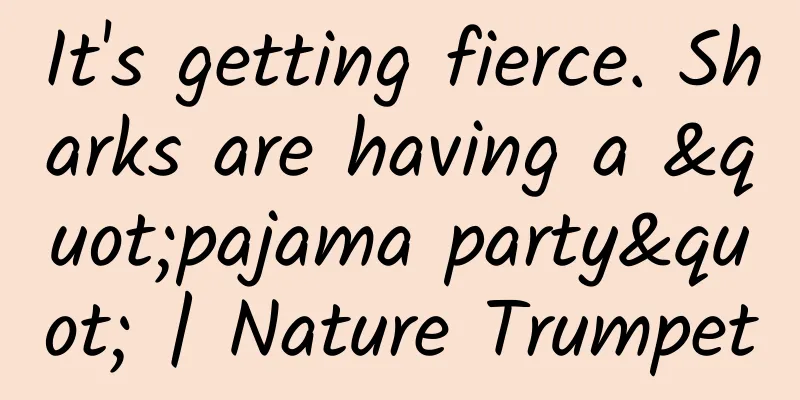It's getting fierce. Sharks are having a "pajama party" | Nature Trumpet

|
Welcome to the 63rd issue of the Nature Trumpet column. In the past half month, we have collected the following natural news and research worth reading: 1) The dodo was not clumsy, but very flexible 2) Humpback whale loses tail after becoming entangled in fishing gear 3) Street lights at night make insects hungry 4) Thousands of sharks having a "pajama party" on the seafloor 5) Chimpanzees talk as fast as humans 6) Octopus and squid pigments can protect against the sun The Dodo Was Not Clumsy In the past, the dodo was often described as a fat, clumsy and "naive" bird; but the latest research has found that this is not the case. According to records, when the Dutch arrived in Mauritius in 1598, the island was full of dodos. Because there was no threat from predators and there was plenty of food, the dodos grew large and fat, weighing more than 20 kilograms. Moreover, they were slow in movement, could not fly, and had no vigilance against humans . Humans began to hunt them, causing the dodo to become extinct a few decades later, becoming the first species recorded by humans and then disappeared. The domestic cat, an invasive species brought by humans, also became a predator of the dodo | Julian Pender Hume Unfortunately, when the dodo became extinct, we still didn't know them scientifically, and we were not sure how many species there were and where they were on the evolutionary map. Recently, British scientists consulted 400 years of literature and studied dodo specimens from all over the UK, including the only dodo soft tissue in the world, and finally revealed the true face of the dodo. Dodo sculpture by paleontologist Karen Fawcett | Karen Fawcett After analysis, scientists confirmed that the dodo belonged to the family Columbidae, and was a relative of modern pigeons. They were not the "naive" image that everyone thought, just sitting and waiting for death. On the contrary, the toe tendons of the dodo were very strong , not inferior to those of existing birds that are good at climbing and flying. They lived in the forest and moved very fast , not at all the clumsy and slow appearance in the legend. Scientists believe that understanding the real life of the dodo can help us understand the dodo's position in the entire ecosystem, which will help us protect existing endangered birds. The dodo was important in the Mauritian ecosystem | Julian Pender Hume Humpback whale tail docking Recently, a humpback whale without a tail was found near Washington State, USA. Drone footage showed that the humpback whale had lost its tail, leaving only a piece of muscle connecting the tail fin to the body, which occasionally emerged from the water. Sadly, it lost its tail not because of a natural disaster, but because of a man-made disaster - researchers speculated that it might have been entangled in fishing nets or other fishing equipment for a long time, and eventually the tail fin was torn off . Humpback whale without tail fin | Anne McKinnell It was first spotted on July 5, and more than 10 days later, a drone spotted it again in another sea area 600 kilometers away. Despite the loss of its tail, it has been swimming hard, almost at a normal speed of 5.5 to 7.5 kilometers per hour. It has developed a new swimming method, initially using its pectoral fins to paddle forward, and later using the remaining muscles in its tail to swing left and right. But scientists believe that the survival of this humpback whale is still worrying. It may not be able to find food normally and eventually die. The last time people saw this humpback whale was at the end of July. Since then, it has disappeared and no one knows whether it is still alive . No tail, but still trying to swim | Eric Guth / The Whale Museum Being entangled in fishing gear is the most common threat faced by whales . In most cases, they can find ways to escape, but they are likely to be injured and their tails may be broken. On the west coast of the United States, there are dozens of cases of humpback whales being entangled every year, and whales with broken tails are found every one or two years. Once whales are entangled in fishing gear and their tails are broken, what awaits them is often a slow tragedy, and they will die in a long and painful death. The street lights are on, and the bugs are hungry. Because the street lights are on all night, insects are almost starving! Recently, researchers including Ma Keming from the Chinese Academy of Sciences noticed that in natural ecosystems, leaves usually show signs of insects gnawing on them, but in urban ecosystems, leaves are surprisingly intact, with few signs of insects . To find out the reason behind this, they set up sampling points on the roads of Beijing and collected nearly 5,500 leaves of Sophora japonica and American red ash, two common street trees in Beijing that are always illuminated by street lights. Beijing Zhongguancun is brightly lit all night long | N509FZ / Wikimedia Commons The analysis found that the stronger the artificial light, the tougher the leaves become, and the fewer signs of insects gnawing on the leaves . The researchers speculated that this may be because artificial light at night prolongs the time of photosynthesis, and plants use more resources to make fibers, resulting in increased toughness of the leaves, making it difficult for insects to chew. In addition, the nutrients in plant leaves are also affected by light. When locust leaves are exposed to stronger artificial light, the nutrient content in the leaves will decrease, and insects will not like to eat them. Although insects are small, they are an important part of the food chain. With fewer edible leaves, the number of insects will decrease, which will trigger a trophic cascade effect in the ecosystem , leading to a decrease in birds and other creatures that prey on insects. The street lights we are accustomed to are bringing about earth-shaking changes to the urban ecosystem. Bugs eating leaves | Daniel Mietchen / Wikimedia Commons Shark Pajama Party Thousands of sharks are having a pajama party on the ocean floor of Australia. Recently, a research vessel was conducting a survey in the Beagle Marine Park in southeastern Australia. After passing through a coral reef, the scene in front of them stunned the scientists: thousands of sharks, densely packed like a carpet on the seabed, all sleeping soundly! Tiger sharks cover the sea floor in Australia | NESP-IMAS This is an Australian tiger shark, which is usually found in southern Australia. They have five gills and can breathe without moving, so they can stay motionless on the seabed for a long time . They are nocturnal, sleeping during the day and foraging at night. They like to eat crustaceans and fish. Before the spawning season in winter, they migrate north to return to their spawning sites. This "slumber party" on the seabed has an entry threshold - only female sharks can attend the party . Scientists speculate that this may be because outside of the mating season, male and female Australian tiger sharks generally live their own lives, and these females just happened to have a full meal of scallops here, preparing to take a short rest before continuing north to lay eggs. Underwater robots and cameras also captured the sponge garden on the seabed | NESP-IMAS This stretch of seabed has become a traditional gathering place for tiger sharks in Australia. During a survey six years ago, scientists also encountered their "slumber party", and the location this time was almost exactly the same as six years ago. Chimpanzee Dialogue Chimpanzees speak quickly, just like humans do—but they use gestures. When humans are talking, the two sides usually take turns very quickly, taking turns every 200 milliseconds on average. Usually, one person is only halfway through speaking when the other person interrupts. This is also a major feature of human communication. In a new study, scientists collected data on more than 8,500 gestures from 252 chimpanzees and analyzed their communication patterns. The results showed that two chimpanzees would also quickly take turns gesturing when communicating, with the shortest interval being only 120 milliseconds, and they would also interrupt each other. Chimpanzees communicate using gestures | David J. Stang / Wikimedia Commons When chimpanzees communicate, there are two ways of taking turns. The first is when one chimpanzee makes a gesture and the other chimpanzee immediately responds with a gesture , which is more like a conversation between humans, such as one asking "Have you eaten yet" and the other answering "Not yet". The other is when one chimpanzee makes a gesture and the other changes its behavior , which is like when humans communicate, one says "Go wash the dishes" and the other responds by walking to the kitchen. When communicating face to face, other species also take turns, but only chimpanzees take turns as quickly as humans, and even interrupt each other . Scientists believe this shows that although humans communicate with their mouths and chimpanzees communicate with gestures, our communication rules are common. Octopus and squid pigments can protect against the sun Many sunscreens currently on the market contain the organic compound oxybenzone and some sunscreens, which can affect the growth of corals and accelerate coral reef bleaching; other marine life may also be affected by the chemical ingredients in sunscreen. Previously, researchers discovered that in the skin of cephalopods such as octopuses and squids , there is a small molecule called xanthommatin that not only helps the animals camouflage themselves, but its optical properties can also filter ultraviolet rays to achieve a sun protection effect . Bleached corals become bare skeletons in the sea | Matt Kieffer / Wikimedia Commons This inspired scientists. Recently, they artificially synthesized this small molecule and combined it with zinc oxide (one of the most commonly used physical sunscreens). Tests found that this synthetic material can not only improve the sun protection effect, but also has no adverse effects on coral reefs . Previous studies have found that sunscreen concentrations as low as 62 parts per trillion can pose a threat to coral reefs, and tens of thousands of tons of sunscreen are discharged into the sea every year. The concentration of sunscreen in the waters near coastal coral reefs has long exceeded the safe range. If the pigments found in octopuses and squids can be artificially produced and replaced with harmful substances in sunscreen, we can protect our skin while maintaining a healthy ocean. References [1]https://academic.oup.com/zoolinnean/article/201/4/zlae086/7733394 [2] https://www.independent.co.uk/tv/lifestyle/humpback-whale-tail-trapped-rope-b2590929.html [3] https://www.frontiersin.org/journals/plant-science/articles/10.3389/fpls.2024.1392262/full [4] https://phys.org/news/2024-08-scientists-girls-shark-slumber-party.html [5] https://www.cell.com/current-biology/fulltext/S0960-9822(24)00761-9 [6] https://onlinelibrary.wiley.com/doi/10.1111/ics.12993 Author: Cat Tun Editor: Mai Mai This article comes from GuokrNature (ID: GuokrNature) |
<<: Two carriages are filled in one minute! How heavy is a heavy-load train?
Recommend
WeChat traffic generation: Who says you have to write soft articles to generate traffic?
In the past two days, friends often asked Yiwanli...
How to collect UGC content through event promotion operations?
1. How to increase the quantity and conversion ra...
Zhang Jinyang - Interpersonal Relationships in the Workplace: 18 Lessons in Dealing with the World
The course is taught by teacher Zhang Jinyang, tit...
"Naruto" ends: Is the domestic Naruto industry chain also over?
Have you ever watched "Naruto"? This co...
Example analysis: How to write a product data report?
Product data reporting is an essential task for p...
Study on debugging Android Native C++ memory leaks
[[433799]] This article is reprinted from the WeC...
Mooncake trivia | Can you believe it? Fruit mooncakes are actually made of winter melon!
According to GB/T19855-2023 "General Rules f...
12 ways to make money: 100,000 yuan a year for beginners to make money with CPS projects
1) Good Project III) Course Introduction 01. The ...
What does it mean when the dragon raises its head on February 2? What are the customs of February 2nd? You will know after reading this
Soon, the first month of the Renyin year will end...
Exclusive interview with Shing-Tung Yau (Part 1): For the future of the nation, we must change China’s scientific culture
Earlier this year, Professor Shing-Tung Yau, an i...
36 data analysis tools you must know!
Today's mobile applications are no longer tool...
Advanced planning guide: 3 theories to solve product, user and competition problems
I think most planners have heard of theories such...
Steps to set up a bidding account. How do newbies in Baidu bidding SEM set up an account?
Speaking of bidding promotion, many people will d...
Which investment projects are the most profitable in 2020? How to find highly profitable projects in 2021?
Today I will tell you how to explore highly profi...
The "Roof of the World" was originally a "Valley"! What happened to the Qinghai-Tibet Plateau?
Author: Han Yangmei The Qinghai-Tibet Plateau, th...









